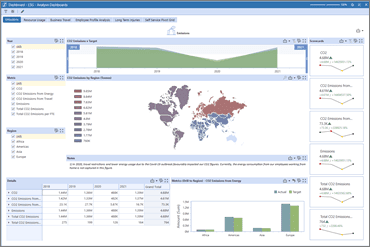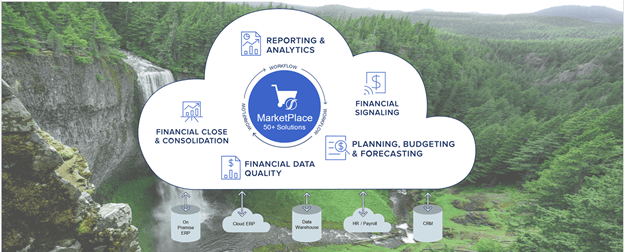In a previous blog article, I highlighted the increasing buzz in the market in the past 12 months around the topic of environmental, social, and governance (ESG) reporting and why CFOs and Finance teams are paying more attention to it. In this article, I’ll highlight why a growing number of organizations are leveraging OneStream to align their ESG reporting with their financial reporting and broader corporate performance management (CPM) processes, and the value that delivers.
ESG Reporting in Focus for CFOs
ESG reporting (a.k.a. Sustainability Reporting) refers to the disclosure of data covering a company’s operations in three areas: environmental, social, and corporate governance. It provides a snapshot of the business’s impact in these three areas for investors, customers, and wider stakeholders. The value of ESG reporting is that it ensures organizations consider their impacts on sustainability issues and enables them to be transparent about the risks and opportunities they face.
For many years, ESG reporting was an annual, voluntary disclosure by public and private companies to their stakeholders about the impacts of their enterprise on the environment and society and how they are managing these programs. With an increasing amount of capital (now roughly $35 Trillion) flowing into “sustainable” mutual funds and ETFs, there is increasing stakeholder interest in ESG reporting and increasing demand for more detailed and frequent disclosures from public and private enterprises.

As a result, corporate sustainability and climate change efforts are fast transitioning from voluntary to mandatory in many countries, and even the US SEC is moving towards defining clear disclosure guidelines for public companies. Based on this inertia, there is a clear driver for companies to develop robust sustainability and ESG strategies with transparent reporting to stakeholders. And this is one of the primary reasons ESG reporting is becoming a hot topic for CFOs and Finance teams.
Aligning ESG Reporting with Financial Reporting
As ESG reporting transitions from voluntary to mandatory it will require the same level of governance, control, accuracy, and auditability as financial reporting. And since CFOs and Finance teams fully understand how to drive control and accuracy in financial reporting, they are best suited to overseeing the collection, consolidation, and reporting of ESG and data alongside financial results.
While ESG reporting is quickly becoming mandatory, meeting an organization’s sustainability objectives will require a management process that’s similar to the corporate performance management (CPM) process that Finance teams employ to help them meet their financial objectives. This process includes goal setting, planning, monitoring and reporting, and analyzing results to track progress and make adjustments as needed to stay on track.

As stated by Accenture in a recent survey report on ESG reporting, “Meeting demands for sustainability data will be integral to company performance. Making a CFO responsible for sustainability is essential for ensuring a company meets its ESG goals. Companies are much more likely to extensively embed ESG in core management processes when the CFO has accountability for ESG metrics.”
Aligning ESG with Financial Reporting and CPM
While many organizations manage ESG reporting via spreadsheets or point applications, both of these approaches create a data collection, consolidation, and reporting process that’s separate from the financial reporting process. And if ESG metrics need to be reported alongside financial metrics, wouldn’t it be better if this data was collected in the same system and processed as financial data?
The answer is yes, and that’s why a growing number of OneStream customers are extending the usage of our unified, CPM software platform to support their ESG reporting and management requirements. OneStream’s platform provides several key capabilities that make it a great fit for ESG reporting. These include the following:
Financial Data Quality: OneStream can load and validate large volumes of financial and non-financial data such as GHG emissions, water and electricity usage with validations and out-of-the-box drill-down and drill-back capabilities to source data providing ultimate auditability. OneStream can connect to any source of ESG data as required such as ERP, CRM, HR systems, and internal data warehouses. The platform can also collect data via flat files, spreadsheets, or data entry forms.
Guided Workflow: OneStream allows customers to design the user experience around the process and apply controls, validation, and governance on ESG data collection, managing the monthly, quarterly, and yearly tasks together. Customers can also leverage the OneStream Task Manager solution to manage and orchestrate the process further and enable email notifications.
Financial Consolidation: OneStream can aggregate and consolidate ESG data and textual commentary quickly to provide company-wide results. With OneStream, your ESG data is consolidated according to the same principles as your financial data, and with the same level of control, governance, and audit trails. Complex ESG data conversions are supported, along with eliminations and partial ownership calculations. Customers can future-proof their CPM solution to support new standards with unlimited configurable dimensions and hierarchies – supporting GRI, SASB, and other frameworks as required.
Reporting & Analytics: In addition to financial and management reports, configurable dashboard visualizations (see figure 1) can provide deep analysis of ESG data and turn it into valuable information and insights. OneStream also supports ad hoc analysis via Microsoft Excel integration, a built-in spreadsheet component, and pivot grids. Integration with MS Office products enables users to produce and distribute PowerPoint decks, Word Docs, and PDFs with ease. Data Blending supports reporting and analysis on high volumes of non-financial data.
Planning and Forecasting: Customers can plan and forecast on ESG with confidence and without compromise. They can set ESG goals and objectives, track Actuals v Target, and provide variance analysis & commentary. Users can perform what-if scenario modeling to understand the impact of ESG policies on financial results and business value. OneStream supports unlimited extensible data models for any ESG planning process.

Based on these capabilities, OneStream’s platform is well-suited to supporting the collection, consolidation and reporting of ESG data and commentary for internal and external reporting. Much of the emissions data can be found in the local ERP systems and sub-ledgers. For example, energy bills, water consumption, fuel usage is all available on the invoices in the ERP data. But the formatting, units, etc., are likely all different and there are many other offline or manual data collection processes that need to happen to bring everything together and holistically report on ESG initiatives.
Customers Leading the Way
OneStream has several customers that are already using our platform to collect, consolidate and report ESG data. One example is a CPG holding company that has grown organically and via acquisitions of many food providers. When they acquire companies, they let them keep their existing ERP systems as they are all manufacturing companies. As a result, they have over 50 different GL/ERPs at 100+ locations.
This organization had been collecting data for financial and ESG reporting via spreadsheets and email, so it was highly manual, time-consuming, and prone to errors. They selected OneStream (see figure 2) to collect, consolidate and report their financial and non-financial/ESG data.

With OneStream the organization now has one system for actuals, budgets, quarterly forecasts, ESG reporting, weekly operations data, and M&A analysis. Having a single system and process saves time and reduces redundancy in data collection. Subsidiaries provide a single submission for financial and ESG reporting. The company has eliminated errors in data collection by using data entry forms with validation checks for key environmental and social metrics.
Conclusion
ESG and Sustainability reporting is rapidly moving from a voluntary to mandatory process. CFOs and Finance teams need to get engaged to ensure the accuracy and integrity of ESG and sustainability reporting to a variety of stakeholders. Aligning ESG reporting with the financial reporting and performance management process and system can eliminate duplication, increase accuracy, ensure compliance and improve the overall management of ESG initiatives.
To learn more, check out our white paper titled “The New CFO Imperative: Unifying ESG & Financial Reporting”, or contact OneStream if your organization is ready to align ESG reporting with financial reporting and get ahead of upcoming disclosure mandates.
Get Started With a Personal Demo



